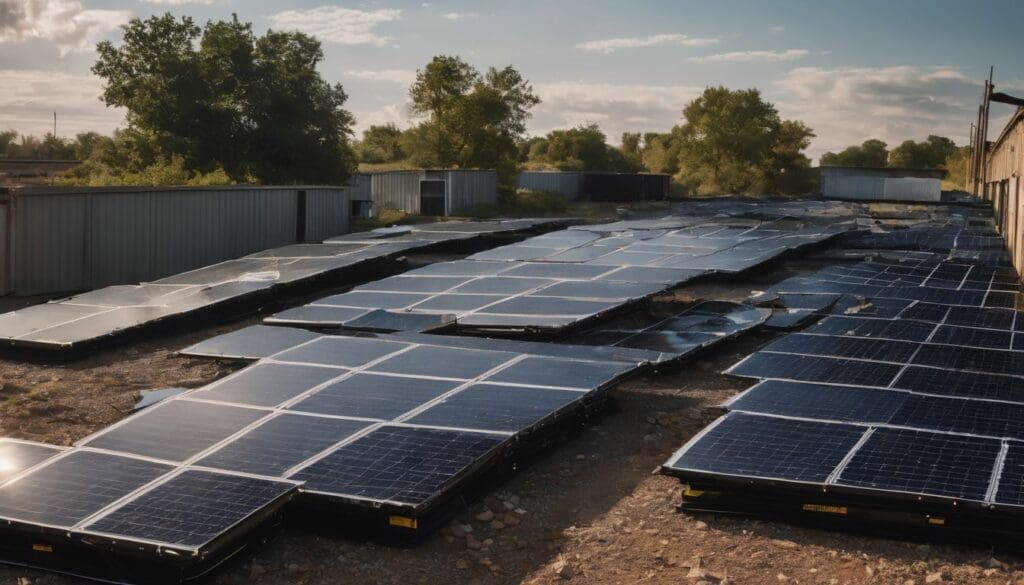As we embrace solar power, we face a growing question: what happens when panels reach their end of life? Remarkably, 90% of a solar panel’s materials can be recycled. This article will explore the importance of proper disposal and how recycling can turn old panels into valuable resources again.
Dive in for a brighter, cleaner future!
Key Takeaways
- Recycling solar panels prevents hazardous materials, such as lead and cadmium, from polluting the environment and conserves raw materials for future use.
- Innovative recycling methods are being developed for solar panels, including mechanical separation and advanced chemical processes to reclaim valuable resources like silicon and rare metals.
- Regulations like the Universal Waste Solar Panel and Lithium Battery Proposal ensure safe disposal practices by treating end-of-life solar panels as universal waste requiring specific management.
- Challenges facing solar panel recycling include high costs, logistical complexities, and a lack of dedicated infrastructure for effective widespread recycling processes.
- Technological advancements, combined with industry collaborations and partnerships, are promoting progress in making solar panel recycling more efficient and cost-effective.
Why is Solar Panel Recycling Important?
Solar panel recycling is important to avoid hazardous waste, promote sustainability, and reduce environmental impact. Proper disposal and recycling of solar panels can prevent harmful chemicals from leaching into the environment and conserve valuable resources for future use.
Avoiding hazardous waste
In the process of recycling solar panels, special care must be taken to prevent harmful substances from harming people or polluting our planet. Materials like lead and cadmium can pose significant health risks if not handled properly.
Recycling facilities are equipped with technology to safely extract these hazardous materials, ensuring they don’t end up in landfills where they could leach into the soil and waterways.
Proper disposal of end-of-life solar panels is a crucial step towards promoting sustainability. By meticulously separating and processing each component, recyclers turn potential environmental hazards into valuable resources.
This approach not only protects the earth but also conserves raw materials for future use. With this vigilant practice, we pave the way for an eco-friendly energy solution that remains mindful of its full life cycle impact.
Transitioning smoothly from addressing waste hazards, let’s consider how renewable energy recycling contributes further to conserving our planet’s health and resources.
Promoting sustainability
To promote sustainability, the responsible disposal of end-of-life solar panels is crucial. By ensuring that solar panels are recycled or disposed of properly, we can reduce electronic waste and minimise the environmental impact of their disposal.
This proactive approach aligns with efforts to protect our environment and support sustainable energy practices for a greener future.
By encouraging sustainable practices in solar panel recycling and disposal, we contribute to the preservation of natural resources while mitigating harmful waste. This active participation supports environmentally conscious efforts towards conservation and green energy initiatives.
Reducing environmental impact
To reduce the environmental impact of solar panel disposal, it is crucial to promote sustainable practices and proper waste management. By implementing effective recycling methods for end-of-life solar panels, we can significantly minimise electronic waste while conserving valuable resources.
Through the reuse of materials and responsible hazardous waste management, we contribute to a cleaner environment and support the ongoing shift towards sustainable energy solutions.
Solar panel recycling not only prevents harmful substances from entering landfills but also contributes to the conservation of natural resources. Embracing environmentally friendly disposal methods enables us to play a proactive role in protecting our planet’s future by reducing pollution and promoting sustainable technology advancement.
How Are Solar Panels Recycled?
Solar panels can be recycled through various methods such as mechanical recycling, chemical recycling, and reusing materials. These processes help to recover valuable materials and reduce the environmental impact of end-of-life solar panels.
Mechanical recycling
Solar panels can undergo mechanical recycling, where they are disassembled and the components sorted for further processing. Firstly, the panels are collected and transported to a recycling facility.
Then, they undergo shredding or crushing to break down the panels into smaller pieces. Next, these pieces go through a process of separation using techniques such as magnetic or electric currents to isolate different materials like glass, silicon wafers, and metals.
Finally, these separated materials can be sent off for re-use in various industries or remanufactured into new solar panels.
Chemical recycling
Chemical recycling of solar panels involves breaking down the panels into their basic chemical components using various chemical processes. This method allows for the recovery of valuable materials such as silicon and other semiconductor materials, which can then be used in the production of new solar panels or other electronic devices.
Through chemical recycling, hazardous substances within the solar panels can be safely neutralised, mitigating potential environmental harm and contributing to sustainable waste disposal.
The use of innovative chemical processes also enables the extraction of rare metals like silver and indium from end-of-life solar panels, reducing the need for mining new resources and promoting a more circular economy within the renewable energy sector.
By embracing chemical recycling techniques for end-of-life solar panels, we can significantly reduce electronic waste while recovering valuable resources that would otherwise go to waste.
Reuse of materials
After the extraction process used in chemical recycling, some of the recovered materials can be reused to create new solar panels or other electronic devices. By reusing these materials, we reduce the demand for extracting raw resources and contribute to a more sustainable approach to energy production.
Reuse not only minimises waste but also supports the conservation of valuable resources like silicon, silver, aluminium, and glass used in solar panels.
The practice of reusing materials from end-of-life solar panels aligns with environmentally conscious efforts towards reducing electronic waste and promoting clean energy solutions.
Regulations and Policies for End-of-Life Solar Panels
The proper disposal of end-of-life solar panels is governed by various regulations and policies, including the Universal Waste Solar Panel and Lithium Battery Proposal, state policies on solar panel disposal, and EPA guidelines for recycling.
To learn more about the importance of these regulations and policies, keep reading!
Universal Waste Solar Panel and Lithium Battery Proposal
The Universal Waste Solar Panel and Lithium Battery Proposal mandates the proper disposal and recycling of end-of-life solar panels and lithium batteries. This initiative aims to streamline the recycling process, reduce environmental impact, and prevent hazardous waste from accumulating in landfills.
By designating these items as universal waste, regulations are put in place to ensure that they are handled with care and processed through authorised facilities.
This proposal not only promotes sustainability but also encourages responsible management of electronic waste. It is an essential step towards achieving a greener future by prioritising the reuse of materials, reducing overall e-waste volume, and contributing to non-profit fundraising efforts for sustainable energy initiatives.
State policies on solar panel disposal
Some states have implemented specific policies for the disposal of solar panels. These policies aim to regulate the safe handling and proper recycling of end-of-life solar panels to minimize environmental impact.
By outlining guidelines for collection, transportation, and disposal of solar panels, these policies ensure that hazardous materials are managed responsibly.
Furthermore, state policies on solar panel disposal also encourage the development and use of specialized recycling facilities. These facilities enable the extraction and reuse of valuable materials from retired solar panels while ensuring compliance with environmental regulations.
EPA guidelines for recycling
When it comes to recycling solar panels, the Environment Agency (EA) provides essential guidelines. These guidelines ensure that the disposal and recycling processes are carried out in an environmentally responsible manner.
The EA regulations aim to reduce the impact of end-of-life solar panels on the environment by promoting safe handling and proper treatment of hazardous materials. Additionally, these guidelines assist in identifying appropriate recycling facilities and ensuring compliance with environmental standards.
Ensuring that end-of-life solar panels are recycled according to EA guidelines is crucial for minimising e-waste and preserving natural resources. By following these regulations, individuals can contribute to a sustainable future through responsible waste management practices.
Challenges of Solar Panel Recycling
The challenges of solar panel recycling include the high cost and logistics involved in the process, as well as the lack of infrastructure for convenient disposal. These factors make it difficult to efficiently and profitably recycle end-of-life solar panels.
Cost and logistics
Solar panel recycling faces challenges in terms of cost and logistics. The transportation and processing of end-of-life solar panels involve significant expenses, while the lack of dedicated recycling facilities adds to the logistical hurdles.
Additionally, separating materials for reuse requires specialised equipment and expertise, further impacting the overall cost and efficiency. Despite these challenges, ongoing efforts focus on streamlining processes and implementing cost-effective solutions to enhance the sustainability of solar panel disposal.
Moving forward with addressing these critical challenges, it’s crucial to explore innovative methods that can drive down costs and streamline logistics for solar panel recycling. Embracing technological advancements and fostering collaborations within the industry are key steps towards achieving an efficient and sustainable approach to managing end-of-life solar panels.
Lack of infrastructure
Despite the challenges in cost and logistics, the lack of infrastructure poses a significant barrier to widespread solar panel recycling. Developing efficient collection systems and establishing dedicated recycling facilities is essential to support the recycling process.
Without an adequate nationwide infrastructure for solar panel recycling, it becomes difficult to manage end-of-life solar panels effectively. Moreover, the absence of specialised facilities hinders the extraction and reuse of valuable materials from retired panels.
Addressing this issue requires investment in infrastructure development and strategic partnerships between recyclers, manufacturers, and policymakers.
The Future of Solar Panel Recycling
Technological advancements in solar panel recycling are improving efficiency and cost-effectiveness. Collaborations and partnerships within the industry will drive innovation and progress in sustainable disposal methods for end-of-life solar panels.
Technological advancements
Technological advancements in solar panel recycling are paving the way for more efficient and cost-effective processes. Innovations in sorting technologies, such as robotic systems and advanced imaging, are streamlining the dismantling process.
These advancements enable precise separation of materials, making it easier to recover valuable components like silicon and glass.
Besides sorting technologies, advances in chemical processes are also enhancing the recycling of solar panels. New methods for extracting and purifying raw materials from photovoltaic cells offer a promising solution for reusing rare metals and minimising waste.
Improving efficiency and cost-effectiveness
Continuing from the advancements in solar panel technology, improving efficiency and cost-effectiveness is essential. Streamlining the recycling process and reducing operational expenses are crucial for making solar panel recycling a sustainable option.
Collaborations between manufacturers, recyclers, and policymakers can drive innovation towards more efficient methods while finding ways to reduce costs associated with collection and processing.
Enhancing the efficiency of solar panel recycling facilities will lead to increased profitability in reusing materials from end-of-life panels. By optimising processes and infrastructure, this industry can continue to contribute positively to environmental conservation without putting unnecessary strain on resources or budgets.
Collaborations and partnerships
To ensure the efficient and sustainable recycling of end-of-life solar panels, collaborations and partnerships between manufacturers, recyclers, and government agencies are crucial.
By working together, these stakeholders can develop innovative solutions to address the challenges of solar panel recycling. Through partnerships, companies can streamline the collection and transportation of end-of-life panels to recycling facilities, promoting a more cost-effective and environmentally friendly approach.
Collaboration also allows for the sharing of best practices and technologies, driving continuous improvement in the solar panel recycling process.
Partnerships with research institutions can lead to breakthroughs in chemical and mechanical recycling techniques, improving efficiency and reducing environmental impact. Moreover, collaborating with regulatory bodies enables industry players to stay updated on policies related to solar panel disposal while advocating for responsible e-waste management.
Conclusion
In conclusion, solar panel recycling plays a vital role in reducing hazardous waste and promoting sustainability. The ongoing development of regulations is crucial to ensure proper end-of-life disposal.
Advancements in technology and collaborative efforts will drive the future efficiency of solar panel recycling.
FAQs
1. What happens to solar panels when they reach the end of their life?
End-of-life solar panels go through recycling or disposal processes, including mechanical or chemical recycling, to safely handle the waste and recover valuable materials.
2. Can old solar panels be reused instead of recycled?
Yes, reuse of solar panels is sometimes possible if they’re still functional; otherwise, they are processed for recycling to manage e-waste properly.
3. Are there any rules about how to throw away old solar panels?
In many places, regulations for solar panel disposal exist to ensure environmental safety and proper management of this kind of e-waste.
4. Is it profitable to recycle used solar panels?
The profitability of solar panel recycling can depend on various factors such as technology available, material recovery efficiency and market demand for recycled components.





